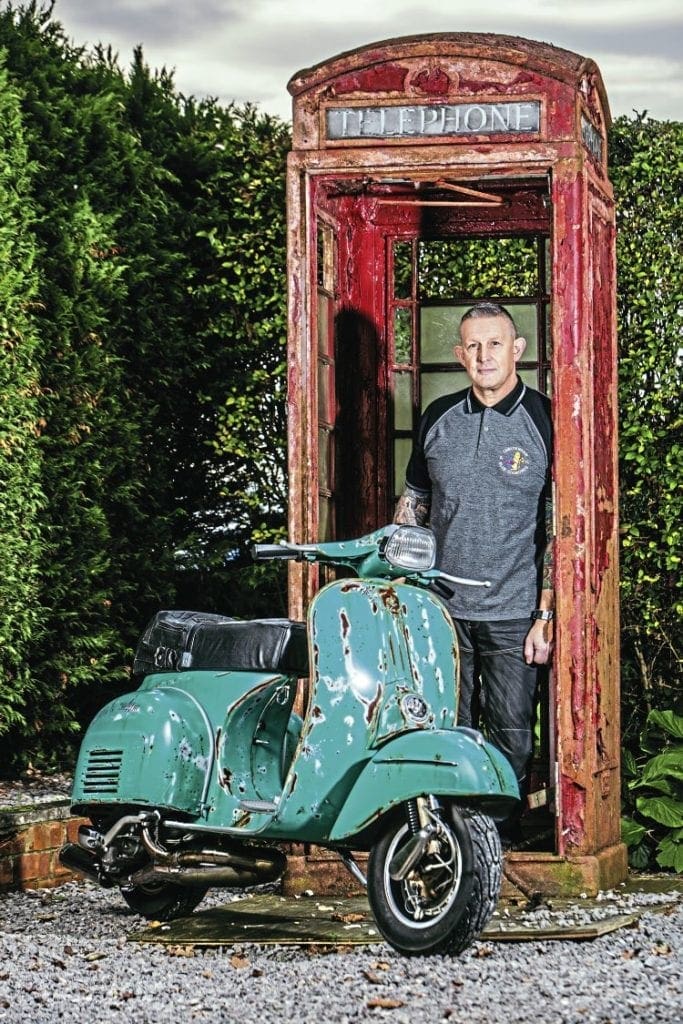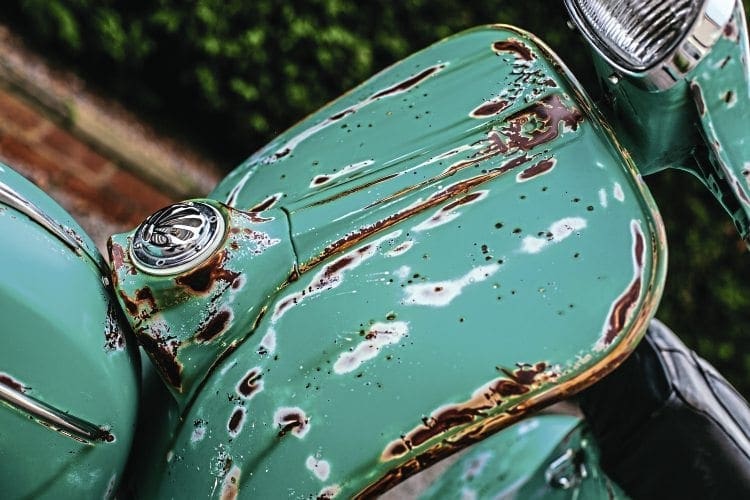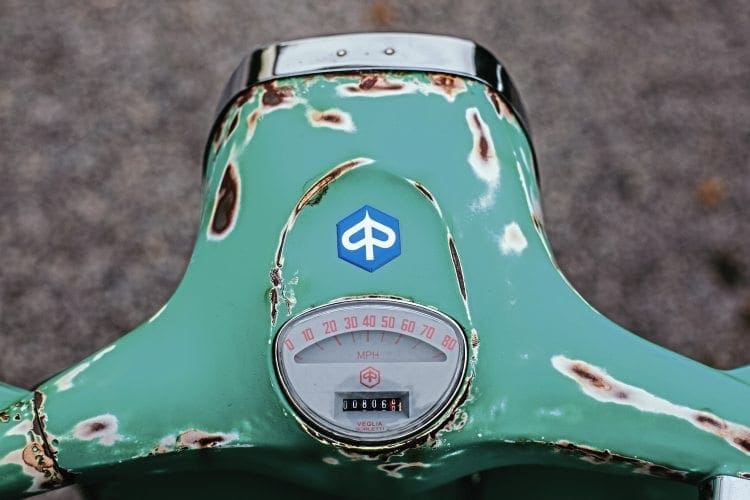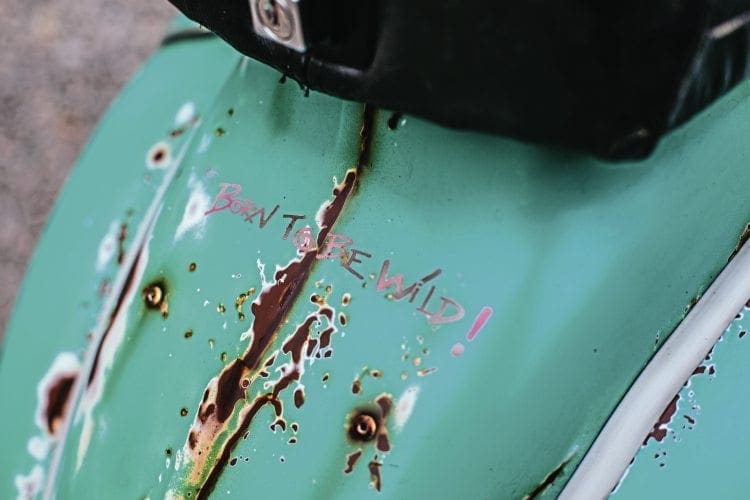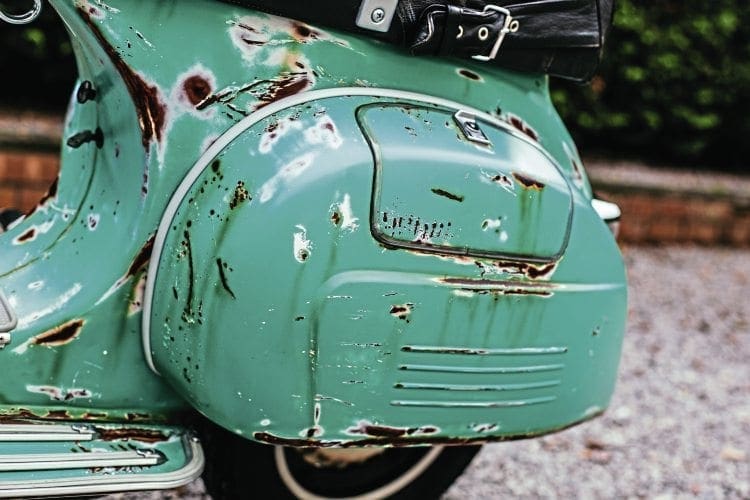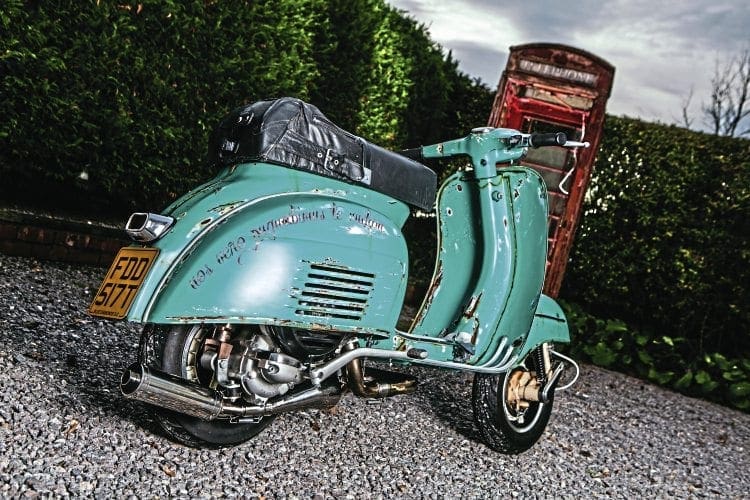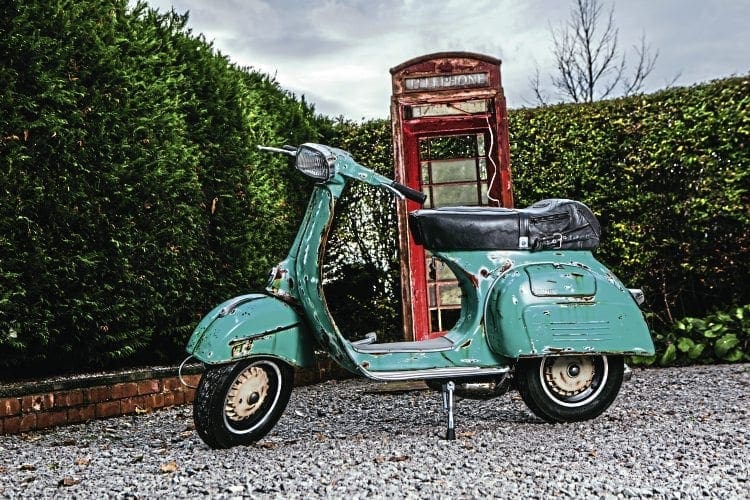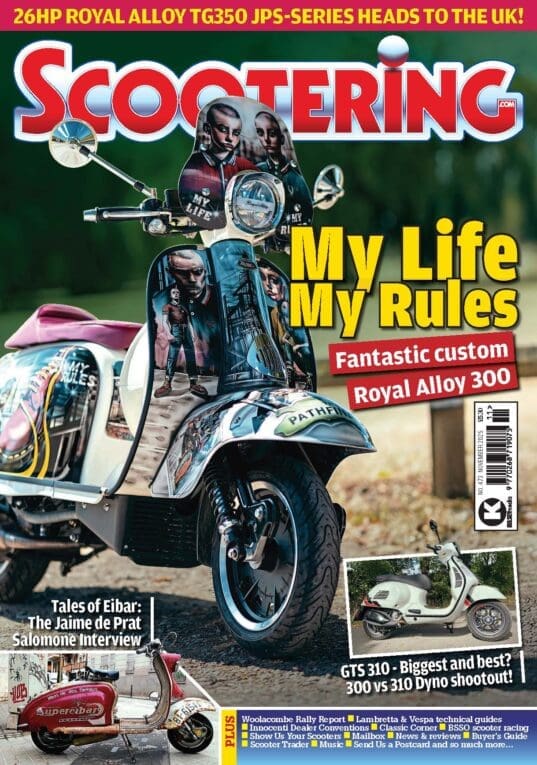We Will Fight You Naked
Rustorations, unrestored, rat rod — call it what you will, it gives a well-used appearance and has become a popular scooter look. It’s an alternative slant to customising or personalising scooters, and a long way from pretty, shiny and pristine full-blown customs.
Given its name it should come as no surprise to learn that the rat rod style emerged on the hot rod car scene. It has since been picked up by VW camper van owners searching for a style removed from the concours standard restoration. It was inevitable that elements of the motorcycle and scooter scenes would get on board this bandwagon.
There are many different approaches that can and indeed are utilised to achieve the required look on classic scooters. One of these is to obtain an untouched organically aged machine, get body and panel parts from different sources albeit from the same model and mix them together, or even strip most of the paint off and treat the bare metal to a deliberately accelerated rusting process.
All deliver the perquisite results to a lesser or greater degree. But, no matter how heavily surfaces are treated with waxes or similar agents, the fact is that once the metal deterioration begins it tends to continue. With vintage scooters continuing to escalate in price, and supply of certain models way outstripping demand, allowing your highly prized machine to rot away in the name of a nice visual effect may not be the smartest move. VW camper owners, the value of whose vehicles can make some scooter price tags look very reasonable, have long been aware of this and as a result use a paint process inspired by and named after a certain kind of metal oxidisation: patina.
This has been used for some time now by camper owners to achieve that tired, worn, well used and abused look, without causing any real damage to the bodywork of the vehicle under the paint process.
Neil Castle, who rides with Cheltenham Blue Diamonds SC, was introduced to the delights of scooters from an early age. Growing up with his dad owning and riding a GS Vespa, Neil’s links to the scene go back further than he can remember. Those early influences certainly ensured Neil would follow in the family tradition of being a Vespa man. Confirmed by his first scooter being a Vespa Primevera, his favourite make and model being the Vespa GS, and his most recent creation being the Patina Vespa Super featured here. Although he’s not prejudiced, currently owning a couple of Lammys and a Gilera Runner as part of his sizeable scooter (and motorcycle) fleet. Now retired, Neil has become something of a habitual, even serial, scooter builder, even more so than he was previously. He currently has several other projects nearing completion. “I like to keep myself busy and active, I build scooters with a view to selling them on, though inevitably once completed they tend to get squeezed into my garage. In reality I tend to only sell them if I need to make some space!”
The Vespa Super, while appreciated by some, even regarded as a genuine classic model by others, is not usually to be found at the top of anyone’s must-own wants list. Uncomplicated, it plods along at a modest speed, invariably doing what’s asked of it without any fuss. Neil acquired the Vespa Super, which has been transformed into how it is today, back in 2013. In just six months he had the paintwork redone and the scooter up, running and back on the road. “I took inspiration from VW camper van rusteration jobs for this project,” he said. “I took it to Re-Born to Be Wild for both the paint and murals. Convincing both Sam and John, as well as myself, that I really did want it to appear looking rough was a bit of a mission. Of course the look I wanted was achieved. Something I’ve noticed happening when people look at my Patina Super, is they tend to reach out and rub their hand over the paint.
“It surprises everyone that it’s actually smooth to touch, not how it seems to appear. That’s the beauty and bonus of patina paint. The name of the scooter is We Will Fight You Naked, the Blue Diamonds club motto in Latin.” It almost goes without saying that Neil wouldn’t have a slow standard engine with a snail-like performance. “I’ve not long changed the engine. When it was first done in 2014 I fitted a Taffspeed 210 motor but this eventually developed a few minor issues with the kickstart, so I decided on a new engine.
“It’s been built to ride, and I intend it to be my rally-going scooter in 2017. I wanted something that would keep up with the Lammy 225s that my club mates ride to the rallies. I treated it to a brand new Pinasco 225, long stroke crank in Pinasco casings, with the tuning and set-up all done at Readspeed. I’m looking forward to giving the Lammy 225s a run for their money — it’ll be interesting to see what it’s really capable of!”
Sometimes sacrifices are made out of necessity when creating a custom scooter. Something that is certainly applicable in regard to Neil’s Patina Super. For the seat he wanted something that was in keeping with the look of the scooter, so he made a very tough call by donating his much loved, much travelled old leather riding jacket to provide the material for the seat covering.
“Gerry at Leathery Elephant, who did a great job with the seat, tried to talk me out of using my old faithful leather jacket as the seat covering. He even used words such as ‘sacrilege’ in his attempt to convince me to change my mind. I’d made my mind up though and stuck to my guns. Gerry even worked a functioning pocket of the jacket into the seat covering, which is not just in keeping with how the rest of the scooter looks, and it’s the business.”
Neil builds scooters to be ridden, despite having completed many projects over the years he has only ever entered one of his creations in a show, and that was on a scooter rally. “I don’t like seeing scooters arriving on trailers or in vans,” he said. “Saying that, and contradicting myself, a few of us have gone to American scooter rallies, we’ve a few planned this year. Over there, given the distance some of them travel to their rallies, it’s understandable why they take them by trailer. I’ve only entered one of my scooters, a1957 Vespa, on a rally show – that was Woolacombe. For me it’s not apathy, it’s more a case of being awake early enough, with an accompanying hangover from the previous night’s partying, to push the scooter down to where the show is.”
Neil’s Patina Vespa Super 225 Pinasco, We Will Fight You Naked, will be at many UK scooter rallies in 2017 with all going to plan. His work in progress current custom scooter projects are set for completion by early spring. I’ve a feeling that this won’t be the last time one of his creations appears as a subject of a feature in Scootering either! Watch this space!
MAN & MACHINE
Name: Neil Castle
Scooter club & town: Cheltenham, Blue & Diamonds
First interested in scooters: Always, dad had a GS (Vespa).
First scooter: Primavera smallframe.
Favourite scooter model: Any Vespa before ‘P’ range. Probably Vespa GS.
Favourite style of custom scooter: Whatever I am working on or building at the time.
First rally or event: Isle of Wight, 1982.
How did you get there: Primavera!
Favourite and worst rally/event: Always enjoy Woolacombe. No worst rally, stayed on some shitty campsites over the years though!
Furthest ridden on a scooter: Northern rallies, 200+ miles each way.
What do you like about rallies/events: Piss up with the lads! (social side)
What do you dislike about rallies/events: People in cars.
Favourite custom/featured scooter: Liked Pride & Poverty Lammy in 80s. Also liked Lammy with coffin sidecar, think it was called the Undertaker (don’t know if it featured). Not a lot beats a standard GS though, as in issue 356.
Name of scooter and reason: We Will Fight You Naked (in Latin – club motto).
Scooter model: Vespa Super.
Date purchased and cost: November 2013, £1500.
Inspiration for project: Rusty old VW vans.
Time to build and by who: Me, six months ish.
Any specialised parts: Seat made out of my old leather jacket – Gerry at Leathery Elephant.
Engine spec: Cases: Pinasco. Kit: 225 Pinasco Cylinder kit. Crank: Pinasco 60mm. Carb: Standard. Exhaust: RHS JL. Clutch: MMW Reinforced cosa. Gearbox: Standard.
Porting & Dyno by: Readspeed.
Are there any other unique details that we have missed: People always rub their hands over it and are surprised it is smooth, it’s paint, honest!
Top speed and cruising speed: Should be good for 80 plus, cruise at 70mph.
Paintwork and murals done by: Re-born to be Wild, Cheltenham. Murals – Sam Cave, paint – John Tooze.
Hardest part of the project: Making it look as rough as possible and convincing others involved as well!
Tips for anyone starting a project: Patina jobs cost a lot more than you think!
Is there anyone you wish to thank: Re-born to be Wild – did exactly what I wanted with it! Leathery Elephant.
VESPA SUPER OVERVIEW
During its production run from 1965 to 1977, it’s estimated that over half a million Vespa Super models were produced. Introduced in late 1965, the very basic Super model as both a 125 and as a 150, each with 8in wheels, replaced the preceding VNB 125 and VBB 150 models. In Italy the 125 was sold in white, while the 150 was in blue. Other colours were used for export Super models.
Frame and side panels were the same as the Vespa Sprint, identical headset and handlebars to those of the Vespa Primevera. For the duration of its production life, the Super engine was near identical to that of the 125 and 150 models it replaced.
In reality Vespa Super was Piaggio’s budget model. Although there were a couple of unique items fitted to them, finned front and rear wheel hubs, similar to those on larger framed Vespa’s and a shorter than other models front mudguard. Super was the first Vespa model to be bestowed a full model name as opposed to an abbreviation.
Evolutionary frame modifications to the Sprint and to a much lesser degree Rally models, found their way onto later examples of the Super. Such as one less floor strut, side panel strips disappearing and a Rally style rear light unit. The 125 models were less popular than the 150, imported by Douglas in reasonable quantity.
The Super continued to be made for export right up until the introduction of the P range. Cheap and basic it may have been, however the longevity of production and amount of Super’s produced speaks volumes about Piaggio’s runt of the litter. Sarge
Words: Sarge
Photographs: Gary Chapman

